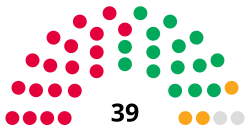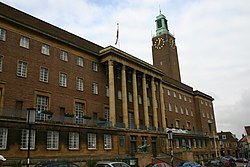Norwich City Council is the local authority for Norwich, a non-metropolitan district with city status in Norfolk, England. It consists of 39 councillors, elected to represent 13 wards, each with three councillors. It forms the lower tier of local government in Norwich, responsible for local services such as housing, planning, leisure and tourism.
Norwich City Council | |
|---|---|
 | |
 | |
| Type | |
| Type | |
| Leadership | |
Louise Rawsthorne since 1 May 2023[2] | |
| Structure | |
| Seats | 39 councillors[3] |
 | |
Political groups |
|
| Elections | |
| First past the post | |
Last election | 2 May 2024 |
Next election | 2026 |
| Meeting place | |
 | |
| City Hall, St Peter's Street, Norwich, NR2 1NH | |
| Website | |
| www | |
History edit
Norwich was an ancient borough and held city status from 1094 when the Bishop of the East Angles moved the seat of the diocese to Norwich.[4] The city was governed by a corporation, also known as the city council. In 1404 the city was made a county corporate with its own sheriffs and quarter sessions, making it administratively separate from the surrounding county of Norfolk.[5]
The city was reformed in 1836 to become a municipal borough under the Municipal Corporations Act 1835. When elected county councils were established in 1889 under the Local Government Act 1888, Norwich was considered large enough to provide its own county-level services, and so it was made a county borough, independent from Norfolk County Council.[6] In 1910 the city council was given the right to appoint a lord mayor.[7]
The city was reconstituted as a non-metropolitan district on 1 April 1974 under the Local Government Act 1972, becoming a lower-tier district authority with Norfolk County Council providing county-level functions to the city for the first time. The city kept the same outer boundaries, but did gain an exclave from Norfolk containing the Shirehall.[8][9] Norwich kept its borough and city statuses and its lord mayoralty.[10][11]
In 2010 it was proposed to convert Norwich to a unitary authority, making it independent from Norfolk County Council. A structural change order was due to take effect on 1 April 2011. Following the 2010 general election, the coalition government came into office and passed the Local Government Act 2010 cancelling the changes.[12]
During November 2023, four Norwich Labour councillors and two Norfolk Labour councillors resigned from the Labour Party and became independent councillors. Four of the councillors issued a statement saying "[W]e no longer consider the current national and local Labour Party matches the overriding principles that guide our work as Town Close councillors".[13][14]
Governance edit
Norwich City Council provides district-level services, including housing, town planning, leisure and tourism. County-level services, including schools, social services and libraries and transport, are provided by Norfolk County Council.[15] There are no civil parishes in Norwich, which has been an unparished area since the 1974 reforms.[16]
The city's territory includes part of The Broads, where town planning is the responsibility of the Broads Authority. The city council appoints one of its councillors to sit on that authority.[17]
Political control edit
The council was under Labour majority control from 2012 until November 2023, when four Labour councillors resigned the whip and the council fell under no overall control.[18]
Political control of the council since the 1974 reforms took effect has been as follows:[19][20]
| Party in control | Years | |
|---|---|---|
| Labour | 1974–2002 | |
| Liberal Democrats | 2002–2004 | |
| No overall control | 2004–2012 | |
| Labour | 2012–2023 | |
| No overall control | 2023–present | |
Leadership edit
The role of Lord Mayor of Norwich is largely ceremonial, and is generally held by a different person each year. Political leadership is provided instead by the leader of the council. The leaders since 1974 have been:[21]
| Councillor | Party | From | To | |
|---|---|---|---|---|
| Arthur South | Labour | 1974 | 1978 | |
| Len Stevenson[22] | Labour | 1978 | 1983 | |
| Patricia Hollis[23] | Labour | 1983 | 1988 | |
| Janet Sillett[24] | Labour | 1988 | 1993 | |
| Alan Waters[25] | Labour | 1993 | 1998 | |
| Nick Williams[26] | Labour | 1998 | 2002 | |
| Ian Couzens[27] | Liberal Democrats | 2002 | 2006 | |
| Steve Morphew | Labour | 2006 | 2011 | |
| Brenda Arthur[28] | Labour | 17 May 2011 | 26 May 2015 | |
| Alan Waters | Labour | 26 May 2015 | 7 May 2023 | |
| Mike Stonard | Labour | 23 May 2023 | ||
Composition edit
The current makeup of the council is:[29]
| Party | Councillors | |
|---|---|---|
| Labour | 19 | |
| Green | 15 | |
| Liberal Democrats | 3 | |
| Independent | 2 | |
| Total | 39 | |
The next election is due in 2024.
Premises edit
The council is based at City Hall on St Peter's Street, overlooking Norwich Market in the city centre. The building was completed in 1938 and is a Grade II* listed building.[30]
Elections edit
Since the last boundary changes in 2019 the council has comprised 39 councillors representing 13 wards, with each ward electing three councillors. Elections are held three years out of every four, with a third of the council (one councillor for each ward) elected each time for a four-year term. Norfolk County Council elections are held in the fourth year of the cycle when there are no city council elections.[31]
Coat of arms edit

The city council's arms consist of a red shield featuring a silver-domed castle above a royal lion.[32][33][34] The blazon of the arms is:
Gules, a castle triple-towered and domed Argent; in base a lion passant guardant Or.[32][34]
The arms appeared on a 15th-century seal and were confirmed during a heraldic visitation in 1562 by William Harvey, Clarenceux King of Arms. According to Wilfrid Scott-Giles, the royal lion was said to have been granted by Edward III.[33] By the 19th century the city corporation had added supporters to the arms—two angels—which were surmounted by a fur cap. These apparently originated in a carving of about 1534 outside Norwich Guildhall. A. C. Fox-Davies noted that "whether or not these figures were then intended for heraldic supporters is a matter for dispute. At any rate there is no official authority for their use".[34] Following the abolition of the county borough of Norwich in 1974, an Order in Council transferred the ancient coat of arms (the shield alone) to the newly created city council.[35] The city council has also received the grant of an heraldic badge, depicting the seal of 1404 encircled by the Lord Mayor's chain.[36]